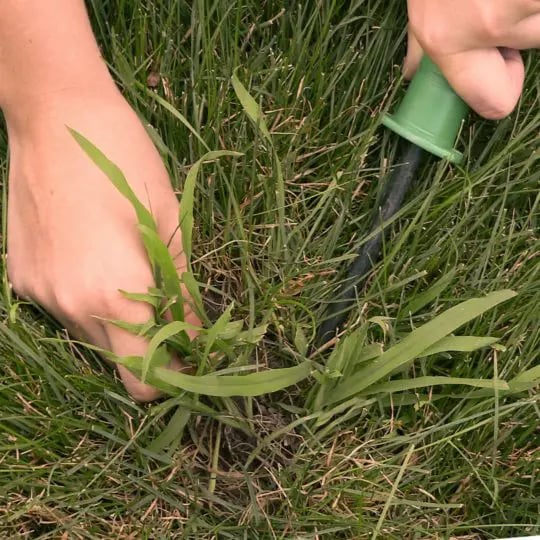How To Get Rid of Crabgrass in the Summer

When it comes to weeds you don’t want on your lawn, crabgrass often tops the list. Even though it is technically classified as a type of grass, crabgrass is quite the eyesore with thick blades that spike in all directions, disrupting the uniform appearance of your lawn. Not only do you have to deal with the unsightly growth pattern, but you have to worry about how tall it grows and how quickly it spreads.
Ryan Petitti, director of technical & quality assurance at Green Lawn Fertilizing, explains why crabgrass is a tough weed for homeowners. “Crabgrass is a challenging summertime weed known as a summer annual. Summer annuals germinate during the early summer months and grow at prolific rates. The plant’s resilience, adaptability, and speed of growth make it challenging to control.
Crabgrass can overtake a lawn quickly and can produce up to 150,000 seeds per plant. Those seeds will remain dormant in the soil until the following summer when they begin germinating again.”
It’s important to get rid of crabgrass in the summer before it becomes unmanageable. Learn your options for taking back your lawn from a crabgrass invasion.
How to Get Rid of Crabgrass in Summer
With Herbicides
You will often hear about two types of herbicides: pre-emergent and post-emergent. Pre-emergent herbicides are used to prevent weeds, while a post-emergent herbicide is a reactive measure you can take to get rid of weeds that are already present, like crabgrass. In addition to getting rid of the weeds you already have, the post-emergent herbicide can help reduce future weed problems by controlling the weed plant before it goes to seed.
The sooner you address your crabgrass problem with a post-emergent herbicide, the easier it will be to get it under control. We recommend applying post-emergent herbicides in the late spring to early summer when crabgrass weeds first appear and are still small. This allows them to absorb the weed control more easily than when they grow bigger and the roots are more extensive.
There are different post-emergent herbicide options and methods for use, so make sure you read the manufacturer’s directions before beginning.
Without Herbicides
If you catch your crabgrass problem early enough, you might be able to kick out the weed without help from post-emergent herbicides.
- Hand-pull. If you only have a few weeds covering your lawn, you can hand-pull them or a weeding tool. The key to this method is making sure you get all of the roots out of the ground and that you don’t allow the seeds to disperse. You can prevent seed disruption by placing the weed in a plastic bag and putting it immediately in the trash.
- Boiling water. Boiling water is a natural method for killing crabgrass. It might require a few applications over a couple of days to officially kill the plant. Be incredibly careful about where you are pouring the boiling water for your personal safety and the health of your lawn. This method can cause you bodily harm, and it will kill every plant in its path—including your grass.
- Proper Mowing. Mowing your lawn at 3.0 – 4.0 inches can significantly reduce crabgrass pressure by keeping the soil cooler and reducing the viable conditions required for crabgrass germination and growth.
Other Tips for How to Get Rid of Crabgrass in the Summer
Weeds are opportunistic plants, invading your lawn when your grass isn’t as healthy as it should be. You can prevent and get rid of crabgrass by focusing on your lawn’s health:
- Water well. Crabgrass thrives in warm, dry conditions, which can be common in the tri-state area of Pennsylvania, Delaware, and New Jersey. Watering your lawn too lightly over the summer can also leave the deep roots of your grass dry while supplying the shallower roots of weeds like crabgrass with moisture. We recommend giving your lawn a good soaking once or twice a week rather than a little bit every day.
- Reseed patchy spots. Grass roots go deep into the ground and take up a lot of space, so when your grass roots are healthy, there isn’t much empty space left in the soil for weeds to take root. Reseeding patchy spots keeps weeds from thriving.
- Mow the right way. Yep, it’s so important we’re mentioning it again. You can help address weed problems by letting your grass grow long enough to create shade at ground level and keep moisture in the soil. And be sure to check your mower because grass that is harmed by a dull blade grows more slowly, giving crabgrass the opportunity to thrive.
- Aerate your soil. Because weeds roots tend to be more shallow than grass roots, compacted soil allows for these invasive plants to thrive. Aerating the soil and reseeding your lawn combats the crabgrass-friendly conditions caused by soil compaction
Green Lawn Fertilizing Knows How to Get Rid of the Weeds in PA, NJ, and DE.
The lawn care experts at Green Lawn Fertilizing know just how to tend to your yard so it’s the greenest and healthiest on the block. Serving our neighbors in Pennsylvania, Delaware, and New Jersey, we know all about the most common lawn weeds in our area and what needs to be done to keep them off your lawn for good. Call us today at 855-469-0692 to get a free quote for our comprehensive Green Lawn Program and to find out more about how we can keep your lawn free from weeds.